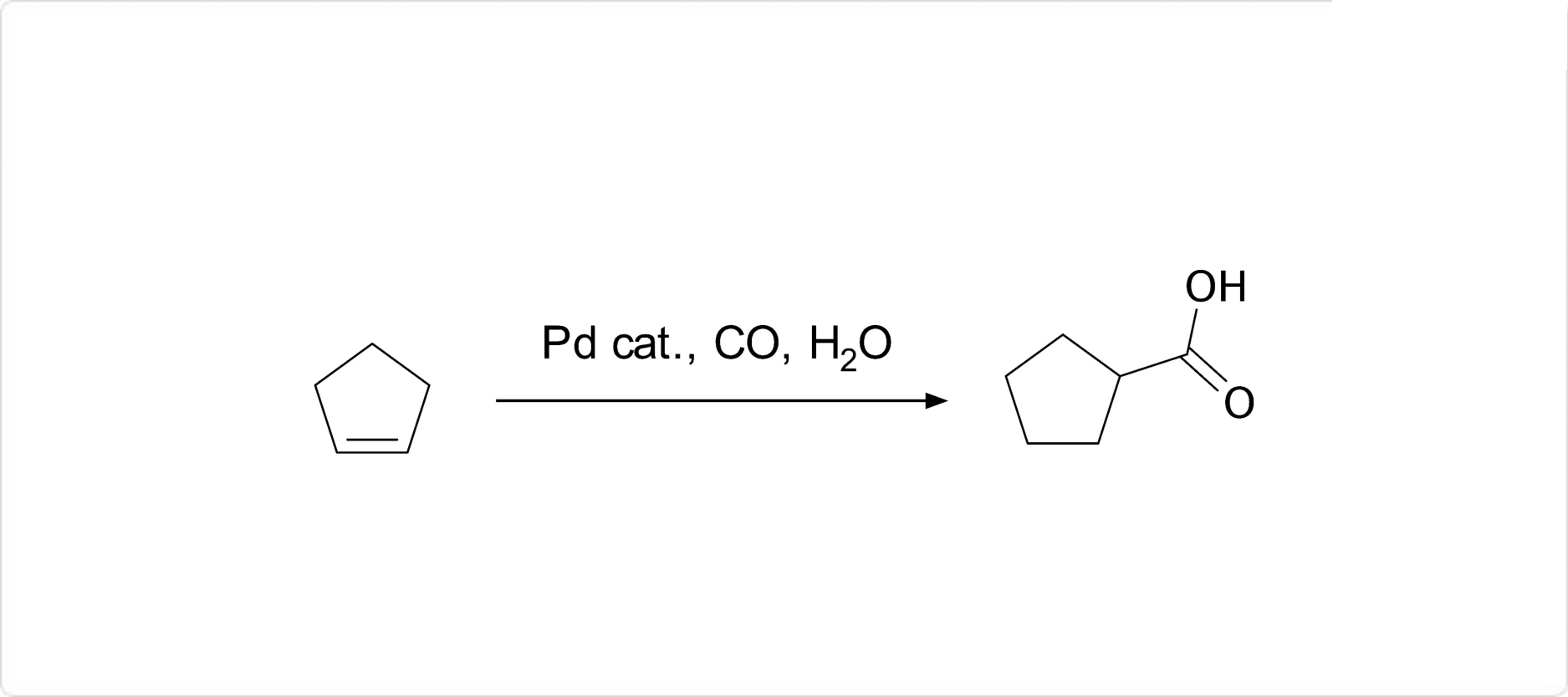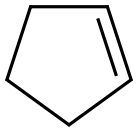-
外観
無色~わずかにうすい黄色, 澄明の液体
-
種類
シクロペンテンは、主に研究開発用試薬製品や工業薬品などとして販売されている物質です。
1. 研究開発用試薬製品
シクロペンテンは、研究開発用試薬製品としては、25mL、100mL、500mLなどの容量の種類がある物質です。実験室で取り扱いやすい容量での提供が一般的です。通常、2-8℃などの冷蔵で保管されます。
2. 工業薬品
工業薬品としては、シクロペンテンは130kgドラムスチールなどの荷姿で販売されています。化学工業における、モノマーとしての用途が想定されている物質です。
-
性質

図1. シクロペンテンの基本情報
シクロペンテンは、分子量68.11、融点-135℃、沸点44℃であり、常温での外観は、無色の液体です。刺激性のある穏やかな甘い臭いを有しています。
密度は0.744g/mL、エタノール、ジエチルエーテル、ベンゼン、四塩化炭素、石油エーテルに可溶です。引火点は-29℃、自然発火温度は395℃となっており、引火性及び可燃性の高い物質です。
-
溶解性
水に不溶。エタノールに混和。エタノール及びアセトンに極めて溶けやすく、水にほとんど溶けない。
-
解説
[別用語参照]シクロアルケン
森北出版「化学辞典(第2版)
-
用途
二重結合部分で開環し重合したポリマーは強度、加工性、耐老化性、耐磨耗性の優れたゴムとして用いられる。
-
合成

図2. シクロペンテンの合成
シクロペンテンの主な工業的合成方法は、ナフサなどの熱分解です。実験室的製法では、シクロペンタジエンを原料にした触媒的水素添加方法による合成が一般的と言えます。また、ビニルシクロプロパンの転位反応 (ビニルシクロプロパン-シクロペンテン転位) によっても合成が可能です。
-
危険性
シクロペンテンは、前述の通り引火性の高い物質です。GHS分類では以下に指定されています。
- 引火性液体: 区分2
- 自己反応性化学品: タイプG
熱、火花、裸火、高温のもののような着火源からは遠ざけることが必要です。また、取り扱いに当たっては、保護手袋、保護眼鏡、保護面などの適切な個人用保護具を着用し、防爆型の電気機器、換気装置、照明機器を使用するなど適切な環境を整えることも重要です。
火花を発生させない工具を使用したり、静電気放電に対する予防措置を講児たりする必要があります。保管に当たっては、換気の良い場所で保管し、涼しいところに置くことが求められます。
-
化学的特性
Cyclopentene is a highly flammable liquid with a low flash
point. It reacts readily with oxidizing agents.
-
物理的性質
Clear, colorless, watery, very flammable liquid with a characteristic sweet, petroleum-like odor.
-
使用
Cyclopentene is a cycloalkene that is cyclopentane having one endocyclic double bond. Vapors heavier than air. Inhalation of high concentrations may be narcotic. Used to make rubber and plastics.
Neopentyl phosphine ligand catalyzed Heck coupling of cyclopentene has been reported. Mechanism of reaction of ground state oxygen atom with cyclopentene has been investigated. Homopolymerization of cyclopentene has been reported. Photocatalytic oxidation of cyclopentene over various titanium(IV) oxide catalyst has been reported.
Cyclopentene was used to investigate the [2+2] cycloaddition of diamond (001) surfaces with alkene.
-
定義
ChEBI: Cyclopentene is a cycloalkene that is cyclopentane having one endocyclic double bond.
-
製造方法
Cyclopentene is synthesized by selective hydrogenation of cyclopentadiene or by dehydration of cyclopentanol. It is produced industrially in large amounts by steam cracking of naphtha. Cyclopentene is present in coal tar, cigarette smoke, and automobile emissions.
-
一般的な説明
Cyclopentene appears as a colorless liquid. Less dense than water and insoluble in water. Flash point below 0°F. Vapors heavier than air. Inhalation of high concentrations may be narcotic. Used to make rubber and plastics.
-
空気と水の反応
Highly flammable. Insoluble in water.
-
反応プロフィール
Cyclopentene may react vigorously with strong oxidizing agents. May react exothermically with reducing agents to release hydrogen gas. In the presence of various catalysts (such as acids) or initiators, may undergo exothermic addition polymerization reactions.
-
健康ハザード
May be harmful by inhalation, ingestion, or skin absorption. May cause eye and skin irritation.
-
火災危険
Special Hazards of Combustion Products: Vapor may travel considerable distance to a source of ignition and flashback. Explosion may occur under fire condition.
-
法規制情報
シクロペンテンは前述の危険性のため、法令によって規制を受ける化合物です。労働安全衛生法においては、危険物・引火性の物に指定されており、消防法において第4類第一石油類に指定されています。法令を遵守して正しく取り扱うことが必要です。
-
使用用途
シクロペンテンの主な使用用途は、化学合成の原料です。特に、各種プラスチックやゴム材料の出発モノマーなどに用いられます。シクロペンテンは、ナフサ分解時に得られるC5留分から大量に得ることが可能な、入手性の高い物質です。
また、分子内に活性な二重結合を有することから、さまざまな用途での使用が研究開発されています。
シクロペンテンを原料として得られる具体的な物質には、シクロペンテンを開環メタセシス重合して得られるシクロペンテンゴムや、抗がん剤や抗ウイルス活性を持つ医薬品として知られるNeplanocin Aなどが知られています。
シクロペンテンゴムは強度、加工性、耐老化性、耐磨耗性の優れたゴムとして有用です。
-
化学反応

図3. シクロペンテンのヒドロカルボキシル化反応
シクロペンテンをチーグラー・ナッタ触媒 (Ziegler-Natta catalyst) を用いて重合させると、1,3-重合反応が起こることが知られています。また、パラジウム触媒を用いてシクロペンテンのヒドロカルボキシル化反応を行うと、シクロペンタンカルボン酸が生成します。
-
安全性プロファイル
Moderately toxic by
ingestion and skin contact. A very
dangerous fire hazard when exposed to
flame or heat; can react with oxidning
materials. Keep away from heat and open
flame. To fight fire, use foam, CO2, dry
chemical.
-
環境運命予測
Biological. Cyclopentene may be oxidized by microbes to cyclopentanol, which may oxidize to
cyclopentanone (Dugan, 1972).
Photolytic. The following rate constants were reported for the reaction of cyclopentene with OH
radicals in the atmosphere: 6.39 x 10-11 cm3/molecule?sec (Atkinson et al., 1983), 4.99 x 10-11
cm3/molecule?sec at 298 K (Rogers, 1989), 4.0 x 10-10 cm3/molecule?sec (Atkinson, 1990) and
6.70 x 10-11 cm3/molecule?sec (Sablji? and Güsten, 1990); with ozone in the atmosphere: 8.13 x
10-16 at 298 K (Japar et al., 1974) and 9.69 x 10-16 cm3/molecule?sec at 294 K (Adeniji et al.,
1981); with NO3 in the atmosphere: 4.6 x 10-13 cm3/molecule?sec at 298 K (Atkinson, 1990) and
5.81 x 10-13 cm3/molecule?sec at 298 K (Sablji? and Güsten, 1990).
Chemical/Physical. Gaseous products formed from the reaction of cyclopentene with ozone
were (% yield): formic acid, carbon monoxide, carbon dioxide, ethylene ,
formaldehyde, and butanal. Particulate products identified include succinic acid,
glutaraldehyde, 5-oxopentanoic acid, and glutaric acid (Hatakeyama et al., 1987).
At elevated temperatures, rupture of the C-C bond occurs forming molecular hydrogen and
cyclopentadiene (95% yield) as the principal products (Rice and Murphy, 1942).
-
純化方法
Free cyclopentene from hydroperoxide by refluxing with cupric stearate. Fractionally distil it from Na. It can be chromatographed on a Dowex 710-Chromosorb W GLC column. Methods for cyclohexene should be applicable here. Also, it has been washed with 1M NaOH solution followed by water. It was dried over anhydrous Na2SO4, distilled over powdered NaOH under nitrogen, and passed through neutral alumina before use [Woon et al. J Am Chem Soc 108 7990 1986]. It was distilled in a dry nitrogen atmosphere from powdered fused NaOH through a Vigreux column (p 11), and then passed through activated neutral alumina before use [Wong et al. J Am Chem Soc 109 3428 1987]. [Beilstein 5 IV 209.]






